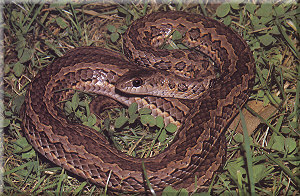MIDDLE AMERICAN SNAKES
Physical Characteristics - The head is moderately set off from the neck with the upper jaw protruding beyond the lower one. The large eyes have vertical slits for pupils. The coloration of the back varies from grayish-brown to yellowish-brown and pale olive brown. The marking of the back and sides consist of a row of dark, roundish or lozenge-shaped blotches that sometimes combine in a zigzag or irregularly undulating band. On the tail the blotches merge into 3 longitudinal stripes that are separated from each other by light lines. The head is a uniform brown or black, and the whitish-yellow belly has gray to black blotches.
Length: Up to 4 feet.
Distribution and behavior - Distributed from western Cape Province eastward and northward across Orange Free State and Natal as far as Transvaal. This terrestial snake occurs in dry savannas and grasslands where it is encountered sometimes in considerable numbers from the coast to high up in the mountains. This is a snake that hardly ever bites, and its Afrikaans name "shaapsteker" is quite misleading. This snake does not represent a threat to sheep or any other fair-sized animal, let alone humans, because its fangs are set too far in the rear of the mouth. Although its neurotoxic venom is similar to that of poisonous elapids and has even more drastic effects, thus far no serious cases of poisoning have been reported.

Physical Characteristics - The rough Greensnake is a very long, thin snake with a narrow head that is barely set off from the neck. The large eyes have round pupils. The scales are keeled, and the anal plate is divided. The back is grass green, turning lighter on the sides. The bell is is porcelain-white, yellowish or pale green.
Length - up to 46 inches.
Distribution and behavior - This snake lives in one connected area reaching from Connecticut to Florida in the east, from Ohio and Indiana to Kansas and Texas in the west, and Tampico, Mexico in the south. It is a truly arboreal species that spends most of its time in low trees, bushes, and tall grass. its color is well adapted to its environment that it is generally overlooked unless it moves. Its favorite hide outs are along the banks of a body of water. Its diet consists of insects, spiders, and even snails and frogs. It can lay up to 12 eggs.
SPOTTED SKAAPSTEKER
